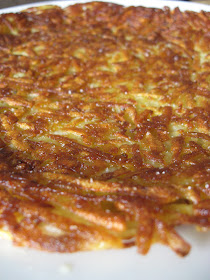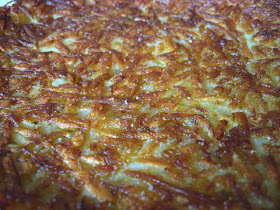Pages
▼
Monday, 5 October 2009
rösti
Announcing the spud themed Potato Week on Morsels & Musings!
My relos, Lynn and Chris, have a farm in Robertson where they grow a number of things including potatoes. This year there was a bumper crop and Jonas and I were lucky to receive a sack of potatoes. They were the most delicious potatoes we have tasted in a long, long time.
In honour of this potato bonanza, starting today, I plan to blog a potato recipe for seven days straight. On the menu is:
Rösti (today)
Tomato & Caper Potato Bake
Tortilla de Rosamaria
Colcannon
Gnocchi w Sage & Burnt Butter
Patatas Bravas
Taleggio & Cambozola Potato Bake
Prepare yourself for a delicious starch and carbohydrate overdose!
Today I begin Potato Week with the delicious Swiss rösti. These pancakes of grated potato are spectacular for breakfast with smoked salmon, as a fair snack or for dinner alongside meat or poultry.
There are great debates about making rösti: whether to use boiled or raw grated potatoes, whether to add ham or cheese or apples, whether to only fry or also bake . . . the list goes on.
Jonas is the rösti maker in our home, and this is the recipe he uses to great, great success.
His rösti are always crispy on the outside and edges, but with a centre of soft, moist potato (yet never mushy).
The only problem with his recipe is that they are too delicious and one is never enough.
Rösti
Jonas’ very own recipe. Makes 2 large (breakfast) or 6 small (sides).
Ingredients:
5 potatoes
3 tablespoons butter
3 tablespoons vegetable oil
Salt and pepper
Method:
1. Parboil potatoes in salted water, for approximately 10 minutes. Potatoes should be firm but not hard.
2. Cool potatoes to room temperature.
3. Coarsely grate potatoes. Season with salt and pepper.
4. Heat oil and butter in frying pan until very hot.
5. Form potato into patty and fry until golden (approximately 5 minutes on each side).
The potato is my theme ingredient for WHB this week.
I have already waxed lyrical about potatoes previously, so forgive me from stealing straight from my own post.
The root of the Solanum tuberosum is the world's most widely grown tuber and is in fourth place as the most produced food crop after rice, wheat, and corn. China and India are the world's largest potato producers.
Research seems to put the potato’s origin in the Andes from Colombia / Venezuela to northern Argentina and the first evidence of cultivated took place in Peru 7,000 years ago. Some 99% of the world’s cultivated potato varieties descend from a subspecies indigenous to South-Central Chile, probably due to the trading routes that carried the first plant exports.
Potatoes made the journey to Europe in the mid 1500s and quickly became a staple food crop, particularly for the poor.
Lack of genetic varieties in Europe left potato crops vulnerable to diseases, such as Phytophthora infestans, which resulted in the infamous Irish famine and a reduction of Ireland’s population by 25% from starvation, disease and emigration to the New World.
The English word potato comes directly from the Spanish patata, which itself is a compound of two Native American words for potato and sweet potato: papa (Quechua) and batata (Taino)
Many Slavic, Baltic, Germanic, Scandinavian and Balkan languages derive their word for potato from an ancient word for potato which also meant “truffle”. French, Dutch, Hebrew, Finnish all have names meaning “earth fruit/apple/pear”, whereas Slovak and Polish use words that mean simply “ground”. Different Chinese languages have meanings such as “foreign taro”, “horse yam” or “earth bean”. Although the Hindi and Nepali word for potato is aloo and in Indonesian it is kentang, I don’t know what the base meaning of these words are.
Potatoes have excellent carbohydrate content but also good levels of Vitamin C, potassium, Vitamin B6 and traces of thiamin, riboflavin, folate, niacin, magnesium, phosphorus, iron and zinc.
The glycemic index (GI) of potatoes can vary considerably depending on the type, location grown, cooking methods and with what it is consumed.
Potatoes contain glycoalkaloids such as solanine and chaconine, which are toxic compounds found in high concentrations in wild potatoes. Light exposure and aging increases toxin levels but cooking at over 170°C (340°F) partly destroys the toxins. Affects are weakness, confusion, headaches, diarrhea and cramps and although coma or death could occur, poisoning from potatoes is very rare.
Common international varieties include Bintje; Désirée; Fianna; King Edward; Kipfler; New; Nicola; Pink Eye; Pink Fir Apple; Red Pontiac; Rooster; Russet Burbank and Spunta.
Fun Wikipedia facts!
• Potatoes are part of the deadly nightshade family, a group of poisonous plants including tomatoes and tobacco.
• There are about five thousand potato varieties world wide. Three thousand of them are found only in the Andes, where over 100 varieties of potato can be found in one valley alone!
• In France the potato was considered suitable only for cattle. In the mid 1700s Antoine Parmentier devised an ingenious strategy to encourage the French peasants to eat potatoes. Apparently he grew a field of potatoes and had it heavily guarded to make it look like a delicacy for the nobility. The peasants stole samples and started to enjoy them.
• Belarus has the world’s highest consumption of potato per capita with each Belorussian consuming 338 kg in 2005.
• The fibre content of a potato with skin equals that of many whole grain breads, pastas, and cereals.
• The notion that all of the potato’s nutrients are found in the skin is an urban legend. While the skin does contain approximately half of the total dietary fibre, more than 50% of the nutrients are found within the potato itself.
Our Weekend Herb Blogging host this week is Susan from The Well Seasoned Cook.
Other potato recipes on the Net are:
Beetroot & Potato Salad - Nami-Nami
Cheddar, Chive & Potato Bread - Apple Pie, Patis, Pate
Crab Boil Potato Salad - Bacon Concentrate
Creamy Garlic Potato Gratin - Freestyle Cookery
Curried Potato Chips - TriniGourmet
Cypriot Potato Salad - Morsels & Musings
Feta Mash - Morsels & Musings
Gamja Jorim (Korean braised potato) - Kitchen Wench
Jeera Aloo (Indian cumin potatoes) - Book of Yum
Lentil & Potato Curry - Cooking with Amy
Potato & Cabbage Casserole - Vanessa Barrington
Potato & Long Bean Rendang - Feeding Maybelle
Potato Breakfast Curry - Morsels & Musings
Potato Chip Cookies - Cooking with Amy
Potato Kugel - Off The Broiler
Potato Skins - Simply Recipes
Potato, Squash & Goats Cheese Gratin - The Kitchn
Pytt i Panna (Swedish hash) - Morsels & Musings
Rosemary Potato Pizza - Apple Pie, Patis, Pate
Rustic Potato Chowder - 101 Cookbooks
Schoppala (Hungarian noodles) - Delicious Days
Schupfnudeln (savoury German noodles) - Book of Yum
Schupfnudeln (sweet German noodles) - Addicted Sweet Tooth
Sour Cream, Potato & Chive Bread - Knead for Bread
Spicy Potato Empanadas - From Argentina With Love
Swordfish & Potato Tortino - The Perect Pantry
Warm Potato Salad w Smoked Trout - Morsels & Musings
-------------------------------------------------------
This time previously on M&M:
2008 - Swedish food
2007 - Mulberry & Cinnamon Cake
2006 - Caprese salad
References:
http://en.wikipedia.org/wiki/Potato
http://en.wikipedia.org/wiki/Great_Irish_Famine





Great rosti recipe. I'm excited to try it... and to see some of the other things you have lined up for the week! I looove potatoes... How lucky are you to get them gifted to you!
ReplyDeleteThis gorgeously fried potato pancake reminds me that the simplest ingredients really do make the very best meals.
ReplyDeleteThank you for your great WHB recipe, Anna!
i am a swiss girl living in NZ, and am delighted to see a rösti recipe on this side of the world ;)
ReplyDeletetry my favorite version, with some melted cheese and a fried egg on top. soooo good!